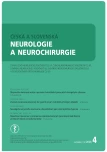Visual evoked potentials can be examined anywhere with the new portable device
Authors:
M. Kuba; J. Kremláček; F. Vít; Z. Kubová; J. Szanyi; M. Chutná; L. Ramešová; J. Langrová
Authors‘ workplace:
Ústav patofyziologie, LF UK v Hradci Králové
Published in:
Cesk Slov Neurol N 2023; 86(4): 245-255
Category:
Original Paper
doi:
https://doi.org/10.48095/cccsnn2023245
Overview
Aim: Visual evoked potentials (VEP) represent an objective non-invasive and inexpensive diagnostic method, particularly in neuro-ophthalmology. A lot of possible diagnostic applications are limited because they are only examined with the use of robust equipment which is hardly transportable and immobile and handicapped patients cannot visit the specialized labs. The aim of our research work was the development of a portable inexpensive VEP device that could be used almost anywhere. Methods: All parts of the last prototype of the device (built-in visual stimulator, recording electrodes, 4-channel EEG amplifier, analog-digital converter, and control unit) with a total weight of 390 g are placed in a headset (plastic “shield” with an adjustable strap). The software for VEP recording and evaluation is used on a standard notebook (PC). The parameters of the device fulfill recommendations of the international societies for clinical electrophysiology of vision and clinical neurophysiology also enabling new applications of so far not routinely used variants of evoked potentials. Testing of the device was done so far in 91 control subjects and 135 neuroophthalmological patients. Results: Pilot studies proved comparable parameters of VEP and diagnostic sensitivity as in standard devices (equal results in 93% of cases). It was verified that the device is usable in various environments, at the patient’s bedside, and also for basic self-examination. Conclusion: The portable device for VEP significantly increases the availability of their examination and thus enables much broader diagnostic applications of this method.
Keywords:
visual evoked potentials (VEP) – neurological diagnostic device – portable VEP device – VEP diagnostic applications – pattern-reversal VEP – motion-onset VEP
Sources
1. RETEVAL DEVICE FOR ELECTRORETINOGRAPHY. [online]. Available from: https: //lkc.com/products/reteval/.
2. Sokol S. Visually evoked potentials: theory, techniques and clinical applications. Surv Ophthalmol 1976; 21 (1): 18–44. doi: 10.1016/0039-6257 (76) 90046-1.
3. Walsh P, Kane N, Butler S. The clinical role of evoked potentials. J Neurol Neurosurg Psychiatry 2005; 76 (Suppl 2): ii16–ii22. doi: 10.1136/jnnp.2005.068130.
4. Kuba M, Kremláček J, Vít F et al. VEP examination with new portable device. Doc Ophthalmol 2023; 146 (1): 79–91. doi: 10.1007/s10633-022-09911-w.
5. Kuba M, Kubová Z. Visual evoked potentials specific for motion-onset. Doc Ophthalmol 1992; 80 (1): 83–89. doi: 10.1007/BF00161234.
6. Schlykowa L, van Dijk BW, Ehrenstein WH. Motion-onset visual-evoked potentials as a function of retinal eccentricity in man. Cognitive Brain Res 1993; 1 (3): 169–174. doi: 10.1016/0926-6410 (93) 90024-y.
7. Kremláček J, Kuba M, Chlubnová J et al. Effect of stimulus localisation on motion-onset VEP. Vision Res 2004; 44 (26): 2989–3000. doi: 10.1016/j.visres.2004.07.002.
8. Heinrich SP. A primer on motion visual evoked potentials. Doc Ophthalmol 2007; 114 (2): 83–105. doi: 10.1007/s10633-006-9043-8.
9. Kuba M, Kubová Z, Kremláček J et al. Motion-onset VEP: characteristics, methods, and diagnostic use. Vision Res 2007; 47 (2): 189–202. doi: 10.1016/j.visres.2006.09. 020.
10. Odom JV, Bach M, Brigell M et al. ISCEV standard for clinical visual evoked potentials. Doc Ophthalmol 2016; 133 (1): 1–9. doi: 10.1007/s10633-016-9553-y.
11. Kremláček J, Kuba M, Kubová Z et al. Within-session reproducibility of motion-onset VEP: effect of adaptation/habituation or fatigue on N2 peak amplitude and latency. Doc Ophthalmol 2007; 115 (2): 95–103. doi: 10.1007/s10633-007-9063-z.
12. VEPpeak – manuál. [online]. Dostupné z: https: //www.veppeak.com/wp-content/uploads/2021/04/VEPpeak-manual_program-description.pdf.
13. Cant BR, Hume AL, Shaw NA. Effects of luminance on the pattern visual evoked potentials in multiple sclerosis. Electroencephalogr Clin Neurophysiol 1978; 45 (4): 496–504. doi: 10.1016/0013-4694 (78) 902 93-6.
14. Kremláček J, Kuba M, Kubová Z et al. Motion-onset VEP to translating, radial, rotating and spiral stimuli. Doc Ophthalmol 2004; 109 (2): 169–175. doi: 10.1007/s10633-004-4048-7.
15. Kuba M, Kremlacek J, Langrova J et al. Aging effect in pattern, motion and cognitive visual evoked potentials. Vision Res 2012; 62: 9–16. doi: 10.1016/j.visres.2012.03.014.
16. Altman DG, Bland JM. Measurement in medicine: the analysis of method comparison studies. The Statistician 1983; 32: 307–317. doi: 10.2307/2987937.
17. Lin LI. A concordance correlation coefficient to evaluate reproducibility. Biometrics 1989; 45 (1): 255–268.
18. Parker RA, Scott C, Inácio V et al. Using multiple agreement methods for continuous repeated measures data: a tutorial for practitioners. BMC Med Res Methodol 2020; 20 (1): 154. doi: 10.1186/s12874-020-010 22-x.
19. Holder GE, Celesia GG, Miyake Y et al. International Federation of Clinical Neurophysiology: recommendations for visual system testing. Clin Neurophysiol 2010; 121 (9): 1393–1409. doi: 10.1016/j.clinph.2010.04. 010.
20. Kubová Z, Szanyi J, Langrová J et al. Motion-onset and pattern-reversal visual evoked potentials in diagnostics of neuroborreliosis. J Clin Neurophysiol 2006; 23 (5): 416–420. doi: 10.1097/01.wnp.0000218241.95542.4f.
21. VEPpeak. [online]. Dostupné z: https: //www.veppeak.com/.
22. Kuba M, Kremláček J, Hulek P et al. Advanced electrophysiological diagnostics of hepatic and portosystemic encephalopathy. Acta Medica 1996; 39 (1): 21–25.
23. Kamino D, Almazrooei A, Pang EW et al. Abnormalities in evoked potentials associated with abnormal glycemia and brain injury in neonatal hypoxic-ischemic encephalopathy. Clin Neurophysiol 2021; 132 (1): 307–313. doi: 10.1016/j.clinph.2020.09.024.
24. Szanyi J, Kremláček J, Kubová Z et al. Visual evoked and event-related brain potentials in HIV-infected adults: a longitudinal study over 2.5 years. Doc Ophthalmol 2019; 139 (2): 83–97. doi: 10.1007/s10633-019-09697-4.
Labels
Paediatric neurology Neurosurgery NeurologyArticle was published in
Czech and Slovak Neurology and Neurosurgery

2023 Issue 4
Most read in this issue
- Diagnosis of root avulsion in brachial plexus injury before surgery
- Psychometric validation of the questionnaire MSQOL-54 in Slovakia – a pilot study
- Clonal hematopoiesis of indeterminate potential is a possible and not yet known cause of stroke
- Visual evoked potentials can be examined anywhere with the new portable device
